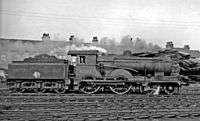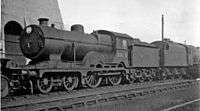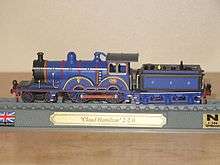GER Classes S46, D56 and H88
| GER S46, D56 and H88 "Claud Hamilton" LNER Class D14/D15/D16 | |||||||||||||||||||||||||||
|---|---|---|---|---|---|---|---|---|---|---|---|---|---|---|---|---|---|---|---|---|---|---|---|---|---|---|---|
 D16/3 'Super Claud' 4-4-0 No. 62530 departs March in August 1958. | |||||||||||||||||||||||||||
| |||||||||||||||||||||||||||
| |||||||||||||||||||||||||||
| |||||||||||||||||||||||||||
| |||||||||||||||||||||||||||
The GER Classes S46, D56 and H88 (classified Classes D14, D15, and D16 by the London and North Eastern Railway) were three classes of similar 4-4-0 steam locomotive designed by James Holden (S46 and D56) and A. J. Hill (H88) for the Great Eastern Railway. They were given the nickname Claud Hamilton after the first engine of the class, named after Lord Claud Hamilton (1843–1925) the chairman of the Great Eastern Railway. None of these locomotives survived to preservation.
History
Allen (1961) noted that
Of all the locomotive designs that emerged from Stratford Works during the reign of James Holden, the one destined to achieve the greatest fame, beyond question, was his Claud Hamilton type 4-4-0, of which the pioneer example, No. 1900 Claud Hamilton, took the rails in 1900.
He devotes a whole chapter to it. It is widely considered one of the classic locomotive designs, and three later Great Eastern Railway classes and three LNER classes were descended from it.[1] F.V. Russell (Holden's Chief Designer) is generally accepted as the Claud Hamiltons' actual designer. Ellis notes:[2]
Mr Holden, by then a valetudinarian was making a long recuperative stay in Egypt.
This was related to Ellis by Russell.
| Year | Order | Quantity | GER Nos. | LNER Nos. | 1946 Nos. | Notes |
|---|---|---|---|---|---|---|
| 1900 | S46 | 1 | 1900 | 8900 | 2500 | |
| 1900 | L47 | 10 | 1890–1899 | 8890–8899 | 2501–2510 | |
| 1901 | M51 | 10 | 1880–1889 | 8880–8889 | 2511–2520 | |
| 1902 | F53 | 10 | 1870–1879 | 8870–8879 | 2521–2530 | |
| 1903 | L55 | 10 | 1860–1869 | 8860–8869 | 2531–2540 | |
| 1903–04 | D56 | 10 | 1850–1859 | 8850–8859 | 2541–2550 | Belpaire boiler |
| 1906–07 | G61 | 10 | 1840–1849 | 8840–8849 | 2551–2560 | |
| 1908 | A64 | 10 | 1830–1839 | 8830–8839 | 2561–2570 | |
| 1909 | B66 | 10 | 1820–1829 | 8820–8829 | 2571–2580 | |
| 1910 | D67 | 10 | 1810–1819 | 8810–8819 | 2581–2590 | |
| 1910 | P67 | 10 | 1800–1809– | 8800–8809 | 2591–2600 | |
| 1911 | E69 | 10 | 1790–1799 | 8790–8799 | 2601–2610 | |
| 1923 | H88 | 10 | 1780–1789 | 8780–8789 | 2611–2620 | Never carried GER numbers in service |
The Railway Magazine of November 1923 includes the log of a run from Liverpool Street to Ipswich with 4-4-0 number 1780, so this loco at least must have carried a GER number. [5]
Accidents and incidents
- On 1 January 1915, locomotive No. 1813 was hauling an express passenger train that overran signals and collided with a local passenger train at Ilford, Essex. Ten people were killed and more than 500 were injured.[6]
- On 12 February 1927, locomotive No. 8808 was hauling an express passenger train that was in collision with a lorry on a level crossing at Tottenham, London. Due to foggy conditions, the train was not travelling at a high speed.[7]
- On 17 January 1931, locomotive No. 8781 was running light engine at Great Holland, Essex when it was in a head-on collision with a newspaper train. Two people were killed and two were seriously injured. The newspaper train had departed from Thorpe-le-Soken station against signals.[8]
- In November 1934, a Class D16/2 8783 locomotive was derailed at Wormley, Hertfordshire when it collided with a lorry on a level crossing. both engine crew were killed.[9]
- On 1 June 1939, locomotive No. 8783 was hauling a passenger train that collided with a lorry on an occupation crossing at Hilgay, Norfolk and was derailed. [10]
Classification


The classification of the Claud Hamiltons is complex but is summarised here:
- GER Class S46 (LNER Class D14), 4 ft 9 in diameter boiler, round-top firebox[11]
- GER Class D56 (LNER Class D15), 4 ft 9 in diameter boiler, Belpaire firebox[11]
- LNER Class D15/1, D15 as built with short smokebox, some with superheater
- LNER Class D15/2, D15 with superheater and long smokebox
- GER Class H88 (LNER Class D16), "Super Claud" with superheater, larger boiler (5 ft 1 1⁄8 in diameter) and Belpaire firebox[11]
- LNER Class D16/1, D16 as built (with short smokebox)
- LNER Class D16/2, as D16/1 but with extended smokebox
- LNER Class D16/3, Gresley rebuild of D15 and D16 with round-top firebox, some with piston valves
Dimensions
The S46 boiler had 1,630 sq ft (151 m2) of heating surface, with a 21.3 sq ft (1.98 m2) grate. The cylinders were 19 x 26 in. with flat valves placed below, operated by Stephenson's motion. The coupled wheels were 7 ft (2.1 m) in diameter.
Performance
(Allen 1961) reports Claud Hamiltons in their original state were capable of taking around 350 tons from Liverpool Street to North Walsham in under the booked time. No. 1882 with round-top boiler ran the 130.2 miles (209.5 km) in 156 min 60 sec. Even heavier trains were managed in the up direction: No. 1809 (Belpaire boiler) took 400 tons up in 157 min 24 sec.
Appearance

The royal blue of the Great Eastern livery, with its scarlet lining, was embellished with a copper chimney cap, and brass beadings round the rim of the safety valve casing, the front and side cab windows, the top and bottom of both cylinders of the Westinghouse brake compressor, the coupled wheel splashers, and the four openings that had been cut in subsidiary coupling rod splashers – in London and North Western Railway style – to give access to the coupling rod pins when the rods were up. In contrast with the blue livery was the vermilion in which the buffer beam and coupling rods were painted. Another feature of great distinction, begun by James Holden with the Claud Hamiltons, was the broad steel ring, polished bright, that encircled the smokebox door, and made it possible to dispense with the usual straps across the door. Before very long, the painted representation of the GER coat-of-arms on the driving splashers was replaced by a replica cast in relief and picked out in colour.[12] The tenders were replaced with standard GER ones when oil firing came to an end. The cab windows were round.[12]
Later in LNER days the locos were painted apple green with LNER on the tender and cab-side numbers. Side rods were polished steel. The appearance was altered when a larger boiler and Belpaire firebox was fitted, meaning a change in the cab window shape as well. 8783 and 8787 were kept in immaculate condition as dedicated Royal locos for hauling the Royal train from King's Cross to Wolferton (for Sandringham). 8783 was also fitted with a copper-capped chimney. Later some locos carried numbers and London & North Eastern Railway on the tender. During the Second World War most were repainted into unlined black livery with the letters "N E" on the tender.
"Royal Claud" 8783 retained its LNER apple green livery into British Railways days (after 1948), but with BRITISH RAILWAYS on the tender initially. Others were painted black with BRITISH RAILWAYS on the tender. Later on they carried both lined and unlined black with the early BR crest and those which survived after 1956 lined and unlined black with the later crest. Many of the class retained steel smokebox door rings until withdrawal, except those rebuilt by Gresley with a larger boiler which also required a new smokebox. Many locos had their decorative valancing removed in later years as well, though they still retained their distinctive character.
| Year | Quantity in service at start of year | Quantity withdrawn | Locomotive numbers | Notes |
|---|---|---|---|---|
| 1945 | 121 | 1 | 8866 | Not renumbered |
| 1946 | 120 | 2 | 2550, 2595 | |
| 1947 | 118 | 1 | 2500 | Name transferred to 2546 |
| 1948 | 117 | 6 | 2504/60/63/83, 2600/02 | |
| 1949 | 111 | 1 | 2594 | |
| 1950 | 110 | 3 | 62508/12/91 | |
| 1951 | 107 | 7 | 62501/03/05/20/28/47, 62603 | |
| 1952 | 100 | 8 | 62502/06/07/09/27/38/90/98 | |
| 1953 | 92 | 2 | 62581, 62616 | |
| 1955 | 90 | 15 | 62525/31/36/41/49/52/54/57/59/73/74/79/85, 62607/20 | |
| 1956 | 75 | 8 | 62523/32/42/51/67/69/77/87 | |
| 1957 | 67 | 28 | 62510/14/16/19/26/33/35/39/46/48/53/56/58/62/65/75/76/78/84/93/96, 62601/05/08/09/11/17/19 | |
| 1958 | 39 | 23 | 62513/15/18/21/22/30/34/43/45/55/61/64/66/68/72/80/86/88/92/99, 62610/14/15 | |
| 1959 | 16 | 12 | 62511/17/29/40/44/70/71/82/89, 62606/12/18 | |
| 1960 | 4 | 4 | 62524/97, 62604/13 | |
In fiction
The design was the basis of the character Molly in the children's TV series Thomas the Tank Engine and Friends.[14]
Preservation
There are no survivors of the original class.
A group based at the Whitwell & Reepham railway plan to build a replica Claud Hamilton D16/2 No. 8783 to be named Phoenix.[15]
References
- ↑ Fry et al. 1981, pp. 1, 3, 18–21
- ↑ Ellis 1965, p. 61
- ↑ Fry et al. 1981, pp. 19, 53–55.
- 1 2 Baxter 2012, pp. 59–67, 105–106.
- ↑ Allen 1923, p. 398.
- ↑ Earnshaw 1991, p. 16.
- ↑ Earnshaw 1990, p. 16.
- ↑ Vaughan 1989, pp. 69-73.
- ↑ Trevena 1980, pp. 36-37.
- ↑ Earnshaw 1990, p. 21.
- 1 2 3 Fry et al. 1981, p. 20.
- 1 2 Ellis p. 61
- ↑ Fry et al. 1981, pp. 53–55.
- ↑ "Molly - Character Profile & Bio". Thomas & Friends - Official Website. Retrieved August 26, 2017.
- ↑ "Claud Hamilton Locomotive Group". Claud Hamilton Locomotive Group. Retrieved 2016-10-14.
Bibliography
- Allen, C.J. (November 1923). "British Locomotive Practice and Performance". The Railway Magazine. Vol. 53 no. 313. pp. 385–400.
- Baxter, Bertram (2012). Baxter, David; Mitchell, Peter, eds. British Locomotive Catalogue 1825–1923, Volume 6: Great Eastern Railway, North British Railway, Great North of Scotland Railway, Midland & Great Northern Joint Railway, remaining companies in the LNER group. Southampton: Kestrel Railway Books. ISBN 978-1-905505-26-5.
- Earnshaw, Alan (1990). Trains in Trouble: Vol. 6. Penryn: Atlantic Books. ISBN 0-906899-37-0.
- Earnshaw, Alan (1991). Trains in Trouble: Vol. 7. Penryn: Atlantic Books. ISBN 0-906899-50-8.
- Fry, E.V.; Hoole, Ken; Manners, F.; Neve, E.; Proud, P.; Yeadon, W.B. (August 1981). Fry, E.V., ed. Locomotives of the LNER. Part 3C. Tender engines—classes D13 to D24. Kenilworth: Railway Correspondence & Travel Society. ISBN 0-901115-52-5.
- Ellis, C.H. (1942). "Famous locomotive engineers: No. 20 James Holden". Locomotive Carriage and Wagon Review. 47: 110–115.
- Ellis, C.H. (1949). Some classic locomotives. London: George Allen & Unwin.
- Ellis, C.H. (1965). The splendour of steam. London: George Allen & Unwin. ISBN 0-04-385016-2.
- Trevena, Arthur (1980). Trains in Trouble. Vol. 1. Redruth: Atlantic Books. ISBN 0-906899-01-X.
- Vaughan, Adrian (1989). Obstruction Danger. Wellingborough: Patrick Stephens Limited. ISBN 1-85260-055-1.
External links
| Wikimedia Commons has media related to GER Classes S46, D56 and H88 / LNER Classes D14, D15, and D16. |